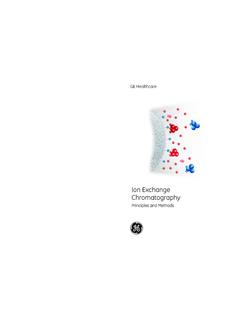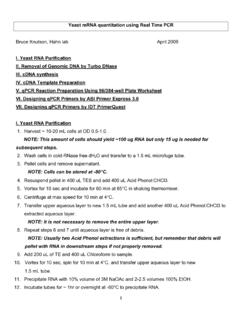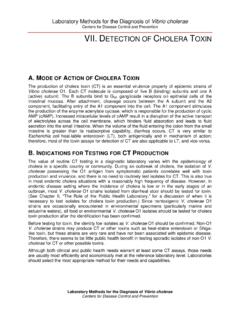Transcription of pET System Manual - Fred Hutch
1 PET System ManualTB055 8th Edition 02/99 Novagen1 United States & CanadaOrders: 800 526-7319 Technical Service: 800 207-0144 Table of ContentsI. About the System3A. Description3B. Licensing and Use Agreement3C. System Components3D. The pET Vectors4 Vector Characteristics and Cloning Strategy4 ligation -Independent Cloning (LIC) of PCR Products4 Fusion Tags5E. Antibiotic Resistance6F. pET Vector Characteristics7G. Hosts for Cloning8H. Hosts for Expression8pET System Host Strain Characteristics9I. Selecting Host Strains10 List of pET System Host Strains and Lambda Phages11J. Media Containing Glucose12K. The T7lac Promoter12L. pLysS and pLysE Hosts12M. Bacteriophage CE613N. Induction Controls14II. Getting Started15A.
2 The pET System Process15B. Growth Media16C. Storage of Strains17D. Vector Preparation17 Recommendations18E. Insert Preparation19 III. Cloning Inserts in pET Vectors20A. Ligation20B. Transformation20 Handling Tips21 Procedure21 Plating Technique22C. Analysis of pET Recombinants22 Transcription/Translation Analysis of PCR Products with STP3 23 ligation PCR for STP3 Analysis23 Colony PCR for STP3 Analysis24 Colony Screening24 Plasmid Miniprep Procedure25 Sequencing26IV. Expressing the Target Gene27A. Expression Host Transformation27B. Induction of DE3 Lysogens27 Preparation for Induction27 Sample Induction Protocol27C. Optimizing Expression27 Plasmid Stability Test27D. Solubility28 Formation of Disulfide Bonds: pET-32, pET-39 and pET-4028E.
3 Toxic Genes and Plasmid Instability29 Use of Ampicillin29 Precautions to Maximize Expression30 Rationale for Plasmid Stability Test30pET System Manual2 NovagenTB055 8th Edition 02/99 United States & CanadaOrders: 800 526-7319 Technical Service: 800 207-0144F. Difficult Target Proteins31 Other Factors Influencing Expression Level32V. Detecting and Quantifying Target Proteins33 Detection/Assay Products for Fusion Tags33VI. Purifying Target Proteins34A. Small Scale Analysis34 Growth and Induction34 Optical Density Analysis of the Induced Culture35 Total Cell Protein (TCP) Sample35 Media Sample35 Periplasmic Fraction Sample Osmotic Shock36 Soluble Cytoplasmic Fraction37 Insoluble Cytoplasmic Fraction38B.
4 Preparation of Cell Extracts with BugBuster Protein Extraction Reagent38 Soluble Fraction38 Inclusion Body Purification38C. SDS-PAGE and Western Blot Analysis39 Normalized SDS-PAGE Gel Loading39D. Large Scale Induction and Fractionation40 Media Fraction41 Periplasmic Fraction41 Soluble Whole Cell Extract Fraction41 Insoluble Whole Cell Extract Fraction Isolation of Inclusion Bodies42 Solubilization of Inclusion Bodies and Refolding Proteins43 Purification Products for Affinity Tags44 VII. Induction Control: -Galactosidase Recombinant45 -Galactosidase Assay45 VIII. Acknowledgments46IX. References46X. Index48XI. Academic and Non-profit Laboratory Assurance Letter50 Copyright 1992 1999 by Novagen, Inc.
5 All rights Tag, T7 Tag, His Tag, His Bind, NovaTope, S Tag, Trx Tag, Dsb Tag, GST Tag, GST Bind, pSCREEN, HSV Tag, Strandase, Pellet Paint,pCITE, Perfect Protein, Perfect DNA, Single Tube Protein, STP3, EXlox, Red Nova, Singles, Clonables, LumiBlot, Xarrest, EKapture,BugBuster, the Novagen name and logo are trademarks and registered trademarks of Novagen, pET System is covered by Patent no. 4,952,496. A non-distribution agreement accompanies the products. Commercial customers mustobtain a license agreement from Brookhaven Science Associates before purchase. The pET-32 vectors are sold under patent license fromGenetics Institute, Inc. For research use only. Licenses for commercial manufacture or use may be obtained directly from Genetics Institute,Inc.
6 , 87 Cambridge Park Drive, Cambridge, MA 02140. The CBD Tag technology is covered under Patent nos. 5,496,934; 5,202,247;5,340,731; and 5,137,819. Use of this technology for commercial purposes requires a license from CBD Technologies, Inc. The GST Tagtechnology is covered under Patent no. 5,654,176, European Patent no. 293,249B1, and Australian Patent no. 607, s primers are designed and sold for use in the Polymerase Chain Reaction (PCR) process covered by patents owned by Hoffmann-LaRoche. Use of the PCR process requires a license. A license for research may be obtained by purchase and use of authorized reagents and DNAthermal cyclers from the Perkin-Elmer Corporation or by otherwise negotiating a license with is a trademark of CBD Technologies, System ManualTB055 8th Edition 02/99 Novagen3 United States & CanadaOrders: 800 526-7319 Technical Service: 800 207-0144I.
7 About the SystemA. DescriptionThe pET System is the most powerful System yet developed for the cloning and expression ofrecombinant proteins in E. coli. Target genes are cloned in pET plasmids under control of strongbacteriophage T7 transcription and (optionally) translation signals; expression is induced byproviding a source of T7 RNA polymerase in the host cell. T7 RNA polymerase is so selective andactive that almost all of the cell s resources are converted to target gene expression; the desiredproduct can comprise more than 50% of the total cell protein a few hours after induction. Anotherimportant benefit of this System is its ability to maintain target genes transcriptionally silent inthe uninduced state.
8 Target genes are initially cloned using hosts that do not contain the T7 RNApolymerase gene, thus eliminating plasmid instability due to the production of proteinspotentially toxic to the host cell (see Section for details). Once established in a non-expression host, plasmids are then transferred into expression hosts containing a chromosomalcopy of the T7 RNA polymerase gene under lacUV5 control, and expression is induced by theaddition of IPTG. Two types of T7 promoter and several hosts that differ in their stringency ofsuppressing basal expression levels are available, providing great flexibility and the ability tooptimize the expression of a wide variety of target of the pET vectors and companion products are available as kits designed for convenientcloning, expression, detection, and purification of target proteins.
9 The pET System provides thecore reagents needed. The background information following System Components will help youdetermine the best vector/host combination for your Licensing and Use AgreementThis T7 expression System , including bacteria, phages, and plasmids that carry the gene for T7 RNA polymerase, is made available under the conditions listed in the Academic and Non-profitLaboratory Assurance Letter. Please refer to the complete list of conditions on the last page ofthis Manual or in the letter received with your System ComponentspET Expression Systems provide core reagents needed for target gene cloning and expression. pET vector DNA, 10 g each of the indicated plasmids Host bacterial strains BL21, BL21(DE3) and BL21(DE3)pLysS, glycerol stocks1, 2 Induction control clone, glycerol stock Novagen Vector Diskette containing all vector sequences (compatible with Macintosh andDOS/Windows)Systems plus Competent Cells contain a set of three host strains ready for high-efficiencytransformation of pET recombinants.
10 These kits include the following additional components,which are sufficient for up to 10 transformations in each host: One ml aliquot of each host NovaBlue, BL21(DE3) and BL21(DE3)pLysS as pretestedcompetent cells SOC medium Test Plasmid1 The pET Peptide Expression System 31 includes host strains BLR and BLR(DE3)pLysS in place of the BL21 series The pET Trx Fusion System 32 includes AD494 series hosts strains in addition to the BL21 series get started quickly, moveahead to page good way to distinguishglycerol stocks from competentcells: glycerol stocks aresupplied in screw-top tubes;competent cells have a flip System Manual4 NovagenTB055 8th Edition 02/99 United States & CanadaOrders: 800 526-7319 Technical Service: 800 207-0144 Components available separately:ProductSizeCat.




